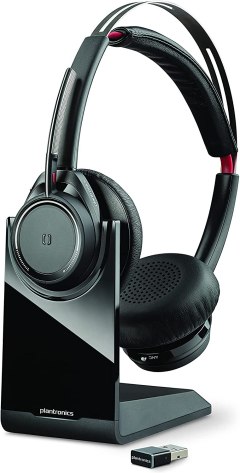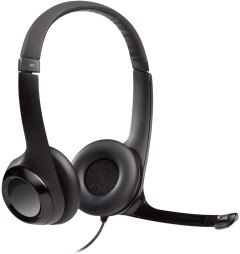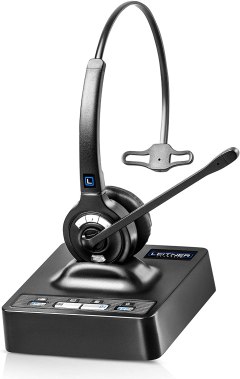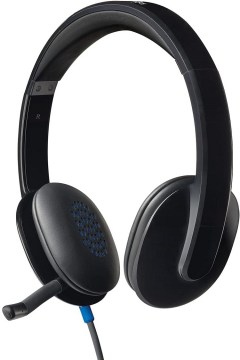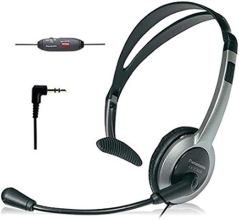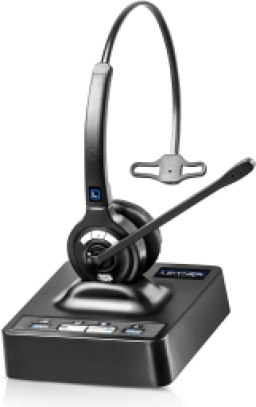Buying guide for best office headsets
Imagine it’s a Monday morning at your office. On your desk is a sky-high stack of notes, assignments, and other things you need to tackle. When it comes to phone calls, you could use a helping hand — or better yet, a hands-free office headset.
Office headsets allow you to engage in telephone conversations without holding the receiver. In some models, you can even program prompts so you don’t need to go through the telephone base. All you need to do is sync the headset to your phone system or plug it into the phone directly. You have a full range of motion with both hands to multitask while you handle conversations throughout the day. Best of all, office headsets are lightweight and comfortable, so there won’t be any more hard phones pressed against your face.
If you’re ready to dial back your traditional telephone use for a more comfortable, efficient alternative, an office headset is a sound decision.
Key considerations
Bluetooth vs. wired
Office headsets are either Bluetooth-enabled (wireless) or wired. Wireless headsets provide the greatest amount of freedom, as you’re hands-free and able to talk at a range of 350 feet from the receiver. Wired headsets, though hands-free, are obviously limited in their range. They still provide a reasonable degree of freedom compared to a traditional phone cord. For the most part, the cord is twice as long.
Boom arm
Office headsets are equipped with a boom arm microphone. These feature varying degrees of adjustability. Some can be moved closer to or farther from your face. Others are stationary. Something to consider when comparing the boom arms between models is whether they have a full arc — if they do, that means you can wear the headset with the earpiece and mic on either side of your face.
Compatibility
Wired headsets are almost always universally compatible, though if you have a USB style, you should double-check this, as not all computers are equipped for advanced USBs. As far as Bluetooth headsets go, there are a couple of types of compatibility to determine. If your office utilizes Unified Communications (UC), check whether your headset model supports their telephone system. For use with a computer for Skype or other video chat applications, check that your software and drivers are up to date. Most headsets work with current versions of Windows. Confirm it with the headset manufacturer’s compatibility list.
Programmability
Office headsets work independently from your regular phone, so their programmability features are located on the headset — or on some wired models, they’re attached to the cord. There are power and volume switches as well as a mute button on most. Some models have a pairing button on the headset, though these may also be located on the charge base. Button location varies between models, but placement tends to be in areas convenient to the user.
We consider stereo office headsets that help you focus as well as single-sided options that let you stay aware of your surroundings.
Included in our search for the best office headsets are products from brands known for producing top-quality business electronics year in and year out.
A clear microphone with effective Clear Voice Capture noise cancellation is one important factor we consider in our search for the top office headsets.
We pay close attention to subtle but meaningful ergonomic features such as an adjustable microphone boom, which helps your voice be clearly heard.
When compiling our shortlist of the top office headsets, we look at simple wired models in addition to those that support advanced wireless standards like DECT 6.0.
In the interest of all-day comfort, we look for the best on-ear office headsets with good sound quality, a light weight, and plenty of ventilation.
We take note of the connectivity options offered by each office headset so you know which video conferencing and telecommunications tools it’s compatible with.
While researching the top wireless office headsets, battery life and connection strength both get plenty of consideration.
We verify each office headset’s compatibility with PC, Apple, and Android operating systems in addition to enterprise frameworks such as Universal Communications.
We verify each office headset’s compatibility with PC, Apple, and Android operating systems in addition to enterprise frameworks such as Universal Communications.
Features
Comfort construction
Office headsets are worn for long periods of time, which is why they are designed with comfort in mind. They’re usually made of hard plastic and metal components for prolonged durability. Most office headsets include a degree of adjustability, particularly when it comes to lengthening the headband or adjusting the boom arm’s location. No matter the size or shape of your face, there’s a setup to fit you well enough for a long day of phone calls.
These tough materials are softened with foam and padding in strategically placed areas. Some earpieces offer thick padded headphones covered by vinyl. Not only do these provide a sort of suction and insulation for sound, they somewhat mould to the shape of your ear. Other styles include a thin layer of foam over the earpiece, which may feel a bit hard or rough to some people. Padding is also seen around the top inside portion of the headband, especially in slightly heavier models. This layer of cushioning between your scalp and the plastic prevents it from digging. If you have long hair, it can reduce creases or matting after long periods of use.
Noise-cancelling technology
Office headsets with noise-cancelling technology are wildly popular in open coworking spaces, call centres, and cubicle offices. The technology is utilized in two different ways: with outgoing sound to the microphone and with incoming sound to the earpiece.
As far as the microphone goes, noise-cancelling features filter out ambient sounds from your environment so your voice is the main sound that transfers to the other end of the line. When it comes to the headphone, this part is equipped with a sort of sound filter that cuts down on the sound around you, especially with the insulation of coverage from a padded earpiece. That means the buzz of cross-conversations, fax machines, and printers are blocked out enough so you can listen to a clear, unobstructed line.
Talk and standby times
Talk and standby times are important for those who expect to spend hours at a time on a headset. Talk time refers to the number of hours of active use, which ranges between nine and 20 hours. Standby time, when it’s not in use, could be ten times as long as the talk time. Of course, these times are mostly estimates, as the time will vary when going between talk time and standby.
Office headset prices
Office headsets cost between $20 and $300, with prices driven by the quality of engineering.
Inexpensive: Between $20 and $50, you mostly find wired headsets. There are some Bluetooth models, though the sound may be mediocre.
Mid-range: Between $50 and $100, headsets are generally Bluetooth headsets that incorporate decent noise-cancelling technology and are more durable.
Expensive: High-end office headsets cost between $100 and $300. These have the longest ranges and reliable charging bases, and they provide the most ergonomic fit. The sound in these headsets is unparalleled.
Tips
- Clean your headset often. Wipe down your headset with a damp cloth or alcohol to clear off grease, dandruff, and dead skin.
- Avoid sharing your headset. Because of all the points of contact with your face, mouth, and nose, it’s easy to transfer germs and sickness if you share your headset.
- Don’t pull on the wire. Only unplug your wired headset from its USB or plug. Pulling on the wire could damage internal components and result in poor connection or total malfunction.
- Clear the area around the base. While the charge base doesn’t take up much room, the headset is an awkward shape and takes up a decent amount of space. Make sure the area is clear to ensure a solid connection during each charge, especially so the headset doesn’t catch on anything that might lift it from the base accidentally.
FAQ
Q. Are office headsets left- or right-side dominant, or can they be worn either way?
A. There are some office headsets that are designed to be worn one way specifically, mostly because their boom mic isn’t adjustable. Many models can be worn with the mic on either side. If you have hearing difficulty in one ear, check whether the headset can be worn with the earpiece on your better side.
Q. Will someone else’s phone or Bluetooth device interfere with my Bluetooth headset?
A. No. You have to pair another device for it to work with your headset, either individually or simultaneously. There is no way for someone else to “dial in” to your phone call, as it would require permission from you. No need to worry about uninvited guests joining your conversations.
Q. My charge base is defective. Can I replace the base instead of purchasing an entire unit?
A. Probably not, as individual pieces of Bluetooth headsets aren’t sold separately. Most likely, you need to replace the whole thing. Before you make another purchase, check whether your office headset and its components are covered under warranty.


